OVERVIEW:
I enjoy taking pictures and I have a fairly large MP3 music collection so I’m always a little worried about having it all backed up in case my computer’s hard drive should crash. Long ago I would back the data up on CD’s, then with the addition of more music and pictures I progressed to DVD’s, and finally to an external USB drive. I’ve now taken it one step further and have installed a Network Access Storage (NAS) device to my home network.
SPECIFICATIONS:
The device I’ve added is Infrant’s ReadyNAS RNV1-S2-X425 which in my configuration comes with 4 x 250gb drives installed. Infrant’s ReadyNAS is actually a stand-alone file server with it’s own operating system and memory (256mb, more can be added) that connects to a network via a built-in 10/100/1000 Ethernet Network Interface Controller (NIC). It has four slide-in hard disk slots, 3 USB 2.0 Ports, and is accessed via a HTTP interface for Web Browsers. It will also support anonymous and user–level FTP/S.
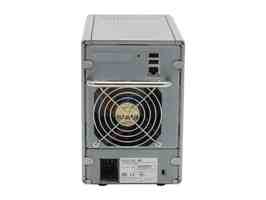
The device supports four different RAID modes, 0, 1, 5, or X-RAID.
- RAID 0 is stripping which is high speed but no protection,
- RAID 1 is mirroring which is slower but protected.
- RAID 5 is striped with checksum with gives fair performance and protection, and
- X-RAID (exclusive to Infrant) which is protected with fair performance and array expandability.
The advantage of X-Raid is that the array size or number of hard disk can be changed without having to reload the data.
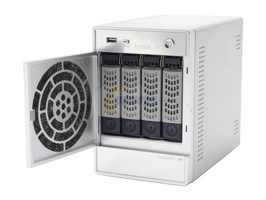
The ReadyNAS also supports hot swappable drives. If a drive fails you pull the failed drive out with the device running and insert the new drive. The ReadyNAS will detect and rebuild the new drive with only a modest decrease in performance. Also if it detects a hard drive that has failed, or is about to fail, it can send an email warning to you.
The device can fit into almost any network and is compatible with Windows, Mac, UNIX and Linux. it supports CIFS/SMB for Windows, AFP 3.1 for Mac OS 9/X, NFS v2/v3 for Linux and UNIX, HTTP/S for Web Browsers, and Anonymous and user-level FTP/S. It also can be assigned an IP address via DHCP, WINS, NTP or as a Static IP. Other option of this device include monitoring of the device status, event logs, temperature, as well as SNMP functions. If connect to an UPS the ReadyNAS can also take action upon power failures. As you can tell it has a lot of functions for such a small (7.9″ x 8.7″ x 5.2″} device.
SET-UP:
Set-up is done using the Web Interface and a set-up wizard. I set the device up using the X-RAID mode. Initially I only set it up using three installed drives. Once the initial formating procedure finished I copied some data to it and then plugged in the fourth drive. The ReadyNAS detected the additional drive and begin adding it to the RAID array. During this internal process I was able to continue to use the ReadyNAS with only a minor noticeable slowdown.
You may set up the drive space as one or multiple volumes and each volume may have multiple shares. For each share you may define individual passwords, file access modes, and quotas. This makes it possible to share the NAS divice with multiple users each having their own storage space and quota to insure that no one person takes all the space.
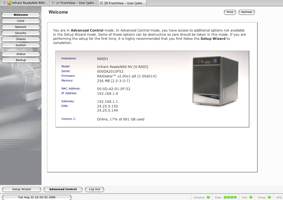
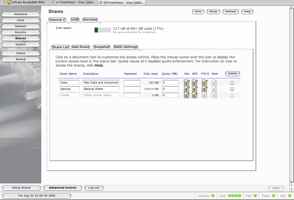
With 1tb (4 x 250gb) of raw disk space the usable space after X-RAID is about 700gb so in effect you give up the space of about one disk for the RAID protection.
PERFORMANCE:
The ReadyNAS and my PowerMac G5 are connect through a 1gb workgroup switch. To test the speed average through-put speed I copied a 232mb file from my Mac to the ReadyNAS and then back again several times and averaged the copy times. The results were:
232mb file – Mac to the ReadyNAS (Writing to the NAS) – 26 sec or 8.92 mb/s
232mb file – ReadyNAS to the Mac (Reading from the NAS) – 23 sec or 10.07 mb/s
Of course this is copying a single large file. Copying many smaller files would no doubt result in slower times and throughput. After a couple months of use, storing back-ups and other data, the performance level has been satisfactory for my own needs.
CONS:
The biggest negative I’ve found to the Infrant ReadyNAS is that it only has a single power supply so if it should fail then the unit is down. But, with this being a home device this isn’t as important as it would be if it was used in a 24/7 operations
SUMMARY:
I use the Infrant ReadyNAS for back-up and to store single copies of large files (movies). Currently I’m backing three Mac’s up to it. I use a back-up software application called SuperDuper! SuperDuper allows you to do smart backups which after the first backup only backs up those objects that change. It will also if you wish delete any old objects in your back-up that is no longer on you current drive. For my largest Mac, I can back up my operating system and all my photo’s and music files to the ReadyNAS each week in about 30 minutes using this method.
I have been very pleased with the Infrant and would recommend it as a good method to back-up, protect, and share data over networks at home or small workgroups. I’ve had no problems with the unit.
Recommended:
Technorati Tags: infrant, nas, readynas, review
Discover more from
Subscribe to get the latest posts sent to your email.
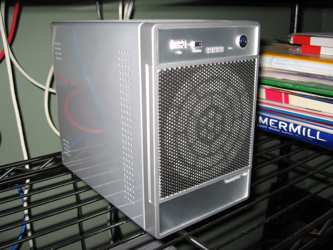
Hey Earl,
Yes, the ReadyNAS NV is a great device. I store just about everything imaginable on the device knowing my data is safe. Of course I have been fortunate enough not to have a hard drive fail on me, but I’m pretty sure that it will do its thing should an event occur. The product is well designed and it just plain works. :)
How loud is the device? By the looks of it, the device seems to have a very large fan.
Thanks for the review!
Hi Ryan,
Under normal conditions the cooling fan runs at a low rpm and doesn’t generate much noise. There is some noise from the four drives spinning in the unit. I would say that it about the same noise as a very quiet PC…a low hummmmmm! My desk is about six feet from the shelf with the unit and I don’t notice the noise.
I now have two of these ReadyNAS units in my house. In the older unit, I upgraded the standard 256MB of RAM very cheaply by removing only a few screws that connect the side panels and the top panel. Be careful snapping the new chip into place. Rumor says these run faster with 1GB, but I can’t prove that. This unit is conncted to a dedicated 1GB interface on my workstation and you really can’t tell that it is any slower than the internal hardware RAID in the workstation.
My second unit is housed in a closet in the basement. It’s used for rotating backups of the various computers (iMac, Ubuntu, WinXP) throughout the house. It also acts as the household web server and (eventually) BITtorrent host. I purchased this in December 2008 with 3TB of disk for under US$1000. Well worth that price.
I recommend you open the case once a year and clean it out. When I changed memory in the older unit I found the top vent holes were clogged with dust. My house isn’t dirty, so I assume this was pure airflow related. This was one of the units that had premature power supply failure fixed under extended Infrant warranty. These folks were great to deal with on that issue.
One CON is the time it takes to recover from a power failure. If they aren’t on UPS, a relatively full disk can take overnight to recover itself. I’ve had that experience more than once so I’m looking to establish an auto-magic power shutdown on power failure behind a UPS.
@Zzyzx Oh: Sounds like you got a nice setup and are happy with it. Great suggestion about cleaning the dust out. I regularly blow out all my computers, routers, switches and external storage units about once per quarter.